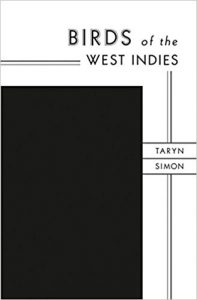Birds of the West Indies
Exhibition and book by Taryn Simon
When I hit the teen years, I started going off to camps, followed by attending a boarding high school. I also started filling stenography pads with words. I would sit in our living room- that place without the television- and write and write. The journeys away from home are relevant because I recall the first few years as: take a trip and then come home and write about all the feelings that had been stirred. Perhaps I should have brought a steno pad with me when I traveled?
Having got involved in the theater a few years later, I spent a few nights contemplating my pile of writings (which I had started transporting). Poetry predominated, but other forms filled many pages. I started tearing out pages and sorting them into piles. For a couple months, I shuffled pages and edited. Eventually, I turned it all into a play which became part of a new playwright festival.
For any artist, their work becomes a conversation with the world around them. That aspect is easy to see in my initial writing when I would see in that big brown easy chair and try to make sense of whatever had happened while I was outside my comfort zone. In many regards, those poems and miscellany are what we think of as art. Certainly, they needed editing and expunging, but that’s the process leading to an audience.
Instead, I horded the words and left them sitting near at hand. One of those weird aspects to being an artist is the fact that we move away from our own creations. (This is not like watching your children grow up, despite the repeated claims.) Simply put, you wake up one day and realize that you have become a consumer of your own work.
Happily,
I still held all the rights to my notebooks and began a second stage of my relationship with them. Essentially, I brought order to the chaos of a part of my past and transformed those words into new work.
Taryn Simon helps bring order to chaos on a much wider scale as her palette takes the familiar, identifies confusion, and provides a mechanism for a new relationship moving forward. Whether it is James Bond, criminal justice, or nuclear power plants, her work feels to me as though it also goes through that two step process that I outline above (though hers is on a much more advanced level). First, you have your initial artistic reaction to the world. Once that reaction begins to abstract for you as an artist, then you take your new viewpoint and turn that into a second artwork, which becomes the piece for public consumption.
Two further thoughts–
This all feels very modern. That may also explain why modern art becomes difficult for many audiences. After all, the intrusion of the artist on the work becomes more apparent. Also, the line between heart and brain appears to favor the brain.
Isn’t this basically how all music works?
What’s it all about?
You’ve Got to Check This Out is a blog series about music, words, and all sorts of artistic matters. It started with an explanation. 105 more to go.
New additions to You’ve Got to Check This Out release regularly. Also, free humor, short works, and poetry post irregularly. Receive notifications on Facebook by friending or following Craig.
Images may be subject to copyright.
